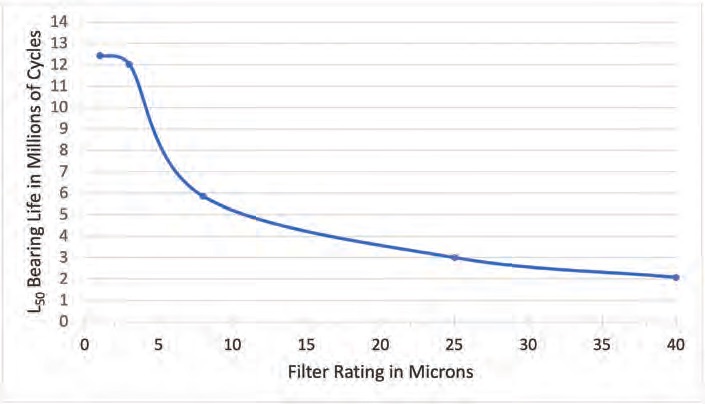The invisible enemy
Evan Zabawski | TLT From the Editor November 2020
Good advice bears repeating.

Adapted from Sayles, R. and Macpherson, P. (1982), “Influence of Wear Debris on Rolling Contact Fatigue,” in Rolling Contact Fatigue Testing of Bearing Steels, ed. J. Hoo (West Conshohocken, Pa.: ASTM International), pp. 255-274.
What is the most damaging size of particle? This is a valid question related to any lubricated component, and one I ask when helping customers improve their lubrication program.
Recently, I had two different encounters that centered around the problem: how to address contamination. The first customer needed help getting their oil analysis reports out of alarm for high particle count and was puzzled the alarms remained even after they switched to 10 μm filters. The second asked for critique of their company’s newly drafted lubrication standard in which they had set an aggressive cleanliness target while stipulating all filtration was to be upgraded to 10 μm filters.
In the first case, the customer questioned their corporate alarm limit for being too low and wanted to raise it, but I had to point out that the issues were focused on their hydraulic systems and, if anything, I would recommend lowering the alarm limit. While they quickly realized that hydraulic systems were more sensitive to particulate contamination than other assets like gearboxes, they did not see why the filters were not going to achieve the desired effect.
The other customer clearly understood just how clean their fluid needed to be but also missed the mark with their suggested filter requirement. What they both needed to know was the answer to the question, “What is the most damaging size of particle?” Before we answer that, let us get some perspective.
The thickness of human hair averages about 80 μm; the lower limit of human detection is generally stated to be about half of that at 40 μm. Truth be told, a younger person with decent eyesight might be able to detect a particle down to about 25 μm, but that is unlikely. Consider that a white blood cell could be upwards of 25 μm and that red blood cells are about 8 μm, but I will wager that even when you were young, you never once looked at blood from a cut and remarked that it appeared polka dotted.
A well-known study of the effect of particle size on bearing life focused on just those sizes of particles. Beginning with a benchmark of 40 μm filtration, the study showed the chosen bearing had an L
50 life of just over two million cycles. Improving filtration to 25 μm garnered another million cycles, and 8 μm filtration nearly doubled it to almost six million cycles. The greatest change was observed when using 3 μm filtration that achieved just over 12 million cycles, but the most interesting development was that 1 μm filtration barely added another 400,000 cycles to the L
50 life. The plot of this data is known as the Macpherson curve.
What the Macpherson curve shows is that this particular bearing’s life was not significantly impacted by particles larger than around 10 μm, but neither was it significantly improved with filtration below 3 μm. The takeaway is the most damaging size of particle, in this case, is around 5 μm. The connection is that this must have to be related to the clearances between the rolling elements and the races.
An article
1 specific to hydraulic systems detailed how particles smaller than the film thickness (i.e., clearance) would pass through causing little damage, and larger particles would not become problematic until they were broken down into smaller particles. The article provided a table of typical dynamic clearances for hydraulic systems before concluding: “Based on these clearances, the critical particle size that must be controlled is typically one to five microns to maximize component life.”
Therefore, the answer to the question, “What is the most damaging size of particle?” is not numerical, but rather a descriptor: clearance sized. What both customers needed to appreciate is that the filter selection also must be driven by the clearance sizes and that common clearances are well below 10 μm.
So, it is not what we can see that causes damage, but rather what we cannot see, and the best advice is to direct our contamination control efforts to those particles we call the invisible enemy.
REFERENCE
1. Pavlat, M.R. (February 1997), “Total Cleanliness Control for Hydraulic and Lubricating Systems in the Primary Metals Industry,”
Lubrication Engineering, 53 (2), pp. 12-19.
Evan Zabawski, CLS, is the senior technical advisor for TestOil in Calgary, Alberta, Canada. You can reach him at ezabawski@testoil.com.